Micro injection is a broadly used in microbiology for decades. DNA microinjection, Nuclear Transfer, ICSI (IntraCytoplasmic Sperm Injection) are commonly practised cellular-injection processes. Especially for nuclear transfer and ICSI applications, a drawn glass pipette is pushed against the biological cell, and a series of force impulses are exerted on it axially to achieve the piercing and ensuing injection. In most advanced applications, a piezo actuator creates this impulsive forcing. This procedure presently requires a very small mercury column inside the glass pipette which is found to be vital for piercing success. This mercury column is necessary, especially for minimizing the transverse oscillations. Despite the toxic mercury the procedure is commonly utilized in many laboratories. Earlier investigations point out that considerable lateral tip oscillations of the injection pipette remain as the piezo-electric pulses are introduced such oscillations impart adverse effects on the success rate of the injection. Impact based piercing has many important parameters to be optimized for successful piercing and survival rate. Optimization of this process needs long period of personal training and high skills of techniques (i.e., pipette manufacturing, mercury preparation, etc.).
We introduce a novel microinjection procedure, which will remedy the shortfalls of the current technology. This procedure is based on a rotationally oscillating pipette motions during the drilling. These oscillations of small amplitudes (few degrees) and high enough frequencies (about 100 Hz) are shown to create very effective piercing. The so-called Ros-Drill© is a mercury-free and minimally invasive device of which the prototypes are designed and built including the relevant peripheral control hardware and software. Preliminary experiments have been done on mouse oocytes and Drosophila embryos. The resutls are very encouraging. In the early trials, blastocyst stage is reported using newdrilling device on mouse and minimally invasive DNA micro-injection for Drosophila embryos.
Conceptual design and the prototypes are in the following pictures.


This video is our presentation for the Connecticut Stemcell Conference 2007.
Intra-Cytoplasmic Sperm Injection (ICSI):

Intracytoplasmic sperm injection is a method of fertilization for mammals. It is successfully used on variety of species and also is a very effective method in treating male factor infertility. ICSI is applied by using two glass pipettes. For example, for mice oocytes the injection pipette that has a tip with 7mm outer and 5mm inner diameters is used to pierce the zona and membrane with rotational oscillations and then insert the sperm, previously separated from its tail, into oocyte. Holding pipette, which has a tip with around 80mm outer and 10mm inner diameters, is holding the oocyte at its tip by a slight suction during the fertilization process. In this configuration injection pipette is moved to touch zona gently and afterwards rotational oscillations are implemented which generate relative angular displacement between pipette and zona.This angular displacement bores a hole through the zona. Then the pipette is pressed on membrane and a dimple is generated. The second oscillation given to pipette pierces the membrane. Injecting the sperm into cytoplasm and pulling back the pipette the process is completed. In the our laboratory the direction of the research is understanding the microdynamics of this process and ultimately automate ICSI procedure. Automation will improve the efficiency of the treating and decrease the cost substantially. For this purpose a novel sensor is designed and prototype is manufactured. In the future work the manipulator will be fully controlled by a digital computer and the closed loop control system will be established. ICSI experiments are conducted in University of California at Davis, Harvard Medical School and University of Connecticut. Here you can see a video clip of Ros-Drill operation:
In our experiments in UC Davis , we achieved high ratio of survival and blastocyst formation in vitro step of the development. These blastocysts are transferred into the uteruses of surrogate mothers and healthy pups are born. The pictures of the blastocysts and the pups are shown below.
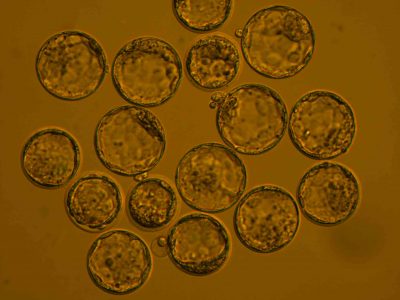
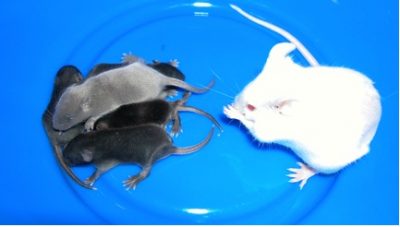
Drosophila DNA Microinjection:


Drosophila is a fruit fly, a little insect about 3mm long, which is also called vinegar fly. It is very valuable organism in biological research, particularly in genetics and developmental biology. Drosophila has been used as a model organism for research for almost a century, and today, several thousand scientists are working on many different aspects of the fruit fly. Its importance for human health was recognised by the award of the Nobel prize. Mutant flies, with defects in any of several thousand genes are available, and the entire genome has recently been sequenced. Researchers are developing models of neurodegenerative diseases such as Parkinson’s and Huntington’s by creating trangenic flies via DNA microinjection. In the heart of process a sharp needle is pushed against posterior of the embryo and DNA is injected. In fact, some of the embryos have tougher membranes and piercing attempts break the needles. By using conventional method, the operator changes more than 10 pipettes for each day depending on the strain of the fruit fly. Drosophila willistoni is one of the tougher membraned fruit flies. We conducted injection experiments using Ros-Drill for piercing. We successfully injected more than couple of hundred embryos without breaking the needle. Drosophila microinjection experiments are conducted in Bloomington Drosophila Stock Center at Indiana University. Video clips of Ros-Drill operation on Melanogaster and Willistoni:
Sensor Development:
A novel non-contact sensing device is developed to detect the tip displacements of a drawn tip of glass pipettes. The physics of the underlying cellular piercing process, however, is presently not fully understood. A non-contact sensor with high motion sensitivity is needed. An optical micro-device is developed for this objective. In the core power four photodiodes receive the light which is channeled through the drawn glass pipette. Appropriate electronics and sensitivity enhancement technique are used. For powerpoint presentation click here.
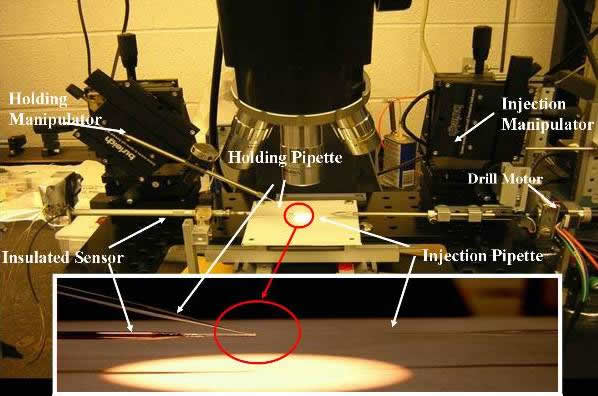
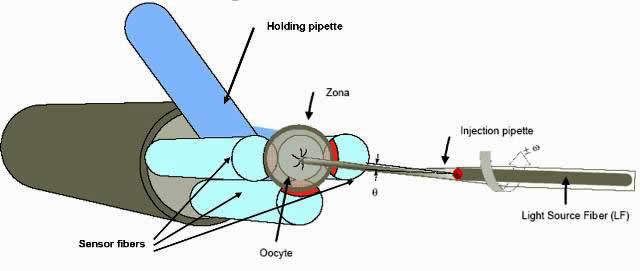
Motion Control
The holding pipette and the injection pipette are manipulated by 3 axis piezo manipulator. Currently these manipulators are controlled by operators via 3-axis joysticks. Our ultimate aim is to automate the process, in other words, taking the human out of the loop!!! This is possible if the manipulators can be controlled by computer. Commercial piezo micro-manipulators are not suitable for this objective. In our laboratory, the drive electronics of the manipulators are modified and now we are able to control the motions by computer signals. Signals are provided by DSP card (DSpace DS1104) and control program is written in MATLAB. For powerpoint presentation click here.
Automation of Ros-Drill©
Ros-Drill© offers a novel technology to perform ICSI. It uses small amplitude and high frequency oscillations at the tip of the injection pipette (of about 6-8 micronΦ.) for piercing. We automate the start of the rotations using visual feedback. Live stream of video images are digitally processed to find the geometric features of the cell deformation, d (see sequence 1-5 in the Fig.). Pipette tip is tracked in real time throughout this operation. This process removes the human decision making. Click here for a power pint presentation.
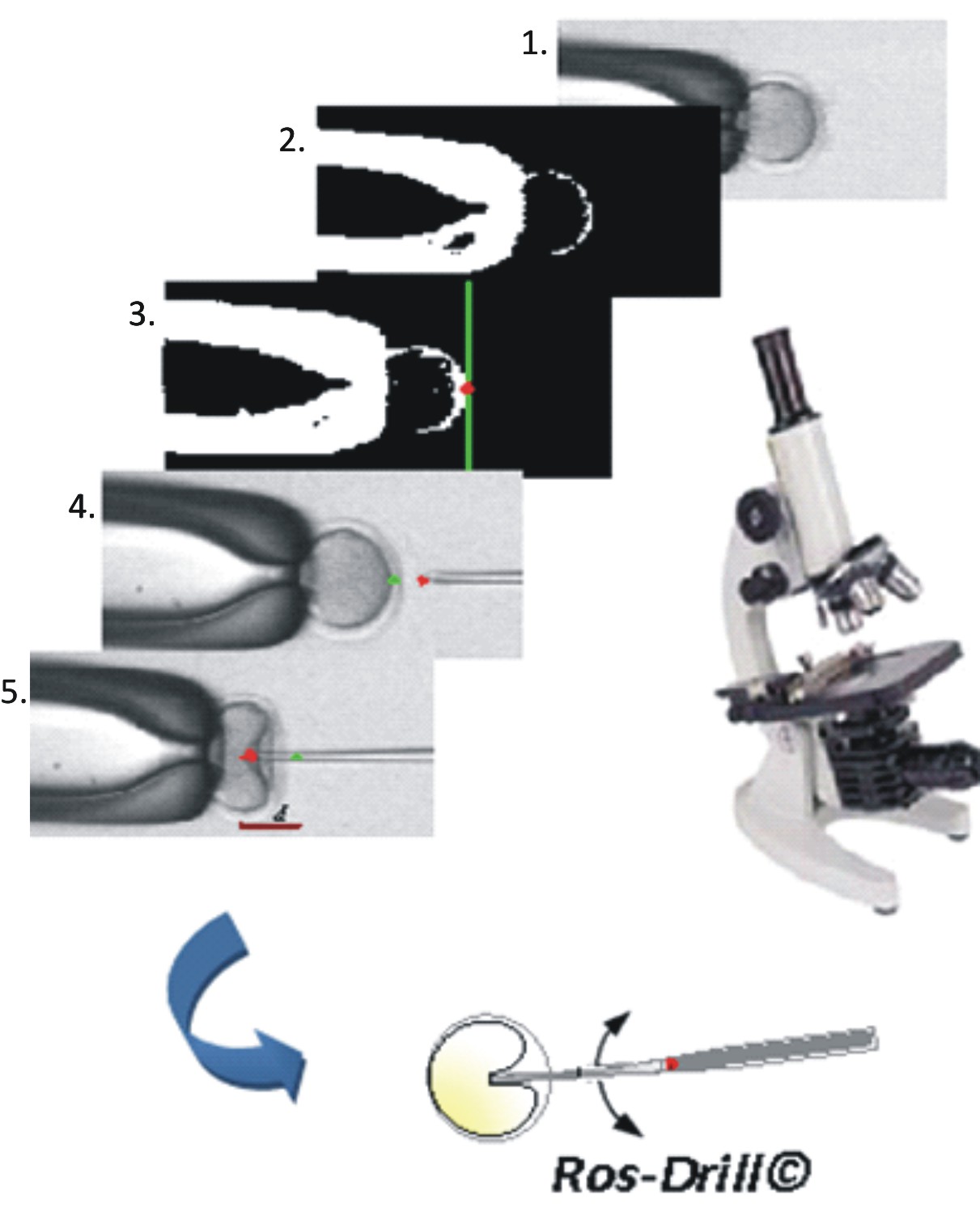
Adaptive Control of Ros-Drill©: New prototype implementation
Ros-Drill© upgrade using a new microcontroller (C8051) and a higher resolution encoder (1000 lines instead of 512) allows the implementation of an adaptive control strategy for the creation of better tracking profiles. For a power point presenttaion, please click here. A report on this can be found here.
| Sampling | Encoder Lines | Encoder Resolution | |
| Old | 1 000 Hz | 512 | 0.176º |
| New | 10 000 Hz | 1 000 | 0.09º |